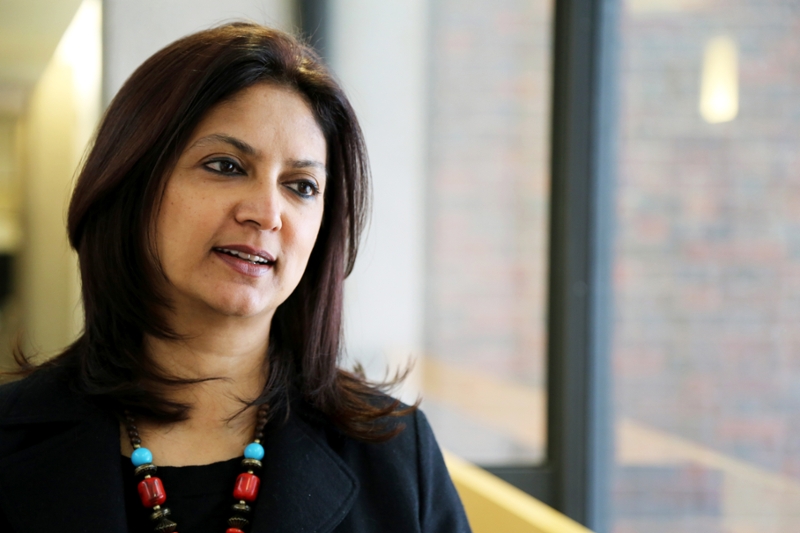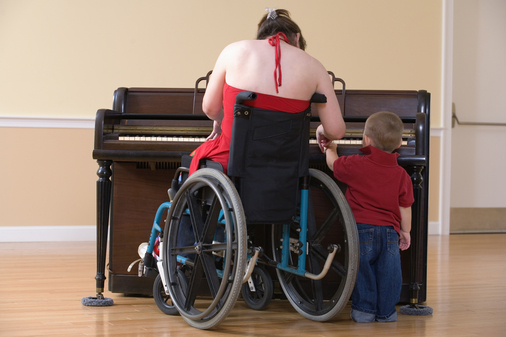When asked about her work, Monika Mitra says, “This is a critical time for all women. And the fact that some women are deprived of quality prenatal and maternal healthcare seems egregious to me. Women with physical disabilities absolutely have the right to equitable healthcare should they choose to become pregnant and have children.”
Since 2013 Mitra, associate professor at the Lurie Institute for Disability Policy, has led National Institutes of Health-funded research on pregnancy and childbirth for women with physical disabilities. Anecdotal evidence and findings from the few studies that exist suggest that women with disabilities are increasingly choosing to become pregnant and have children. “Yet,” Mitra says, “there is no systematic body of work looking at this, partially because there’s really no data.”

Mitra analyzed the limited data that exists and supplemented it with a survey and a series of interviews. She spoke to 25 mothers with physical disabilities as well as 14 clinicians, among them many who specialize in providing prenatal care to women with disabilities. Mitra and co-investigators at UMass Medical School, Massachusetts General Hospital and Villanova University report their findings in an article titled “Pregnancy Among Women with Physical Disabilities: Unmet Needs and Recommendations on Navigating Pregnancy,” to be published in the Disability and Health Journal in July.
The data shows that women with disabilities were less likely to access care during their first trimester and more likely to have pregnancy complications and poor birth outcomes. The interviews provided a more nuanced story, one in which information, education and awareness are often lacking.
In those conversations, the women consistently told Mitra and her team that they wanted more information. “A lot of women who decided to become pregnant did a lot of their own research and found that there wasn’t much out there. Many reported that their providers didn’t seem to have enough information either. The other thing women wanted was peer support, to actually talk to and learn from other women with disabilities who have gone through this.”
Clinicians echoed the need for more guidance and training. “We need to change medical education and clinical practice guidelines,” Mitra says. “Many providers don’t know how to interact with women with disabilities.” Eventually Mitra and her co-investigators intend to work with the American Congress of Obstetricians and Gynecologists (ACOG) to develop prenatal care practice recommendations for physicians treating women with disabilities.

In one interview, a physician said, “You’re trying to do your best, but if you haven’t been educated on specifically how to work with people that have contracted muscles, for example, it’s kind of hard to get them … in a position comfortably where you can, insert a speculum and do a [gynecological] exam. It can be, as you can imagine, incredibly traumatic.
“There’s still stigma around sexuality and reproduction for women with disabilities,” Mitra says. “We heard from women who went to the doctor with their partner or husband, and the doctor assumed that the man accompanying her was a personal care attendant.” Some women described being viewed by their clinicians as asexual. One woman said, “I think probably the weirdest [comment] was…from my doctor…He asked us how we got pregnant, and if we had used a turkey baster.”
Despite the passage of the Americans with Disabilities Act over 25 years ago, patients also reported an alarming lack of accessibility in many physicians’ offices. Many of the women Mitra interviewed reported that exam tables and weighing scales were rarely accessible for persons with disabilities. Some went through an entire pregnancy, had a cesarean and recovered from the cesarean, never once having been weighed.
Affordability and patient accessibility of health care facilities and services also play a role. Mitra recalled the example of a woman she spoke to who has dwarfism. “All she needed in terms of accessibility was a stool. She had a cesarean birth, and kept the stool next to her hospital bed to enter and exit the bed. But in order to use the restroom she then had to carry the stool into the bathroom. You can barely walk after a cesarean, let alone carry things. How much does it cost to put a second stool in the bathroom?”
Research like this is a monumental contribution to a growing body of literature. “Public health always thinks of disability as an outcome, something to be prevented,” Mitra says. “You wear a seatbelt, you look both ways before crossing the road, you don’t smoke. That’s a really important function of public health, but we also need to consider the health of people who do have disabilities. If we only work from anecdotes or really small studies that aren’t population based, we’ll never advance the field. In order to eliminate these disparities, we need to study this systematically.”
A condensed version of this article will appear in the fall 2016 issue of the Heller Social Policy Impact Report.
